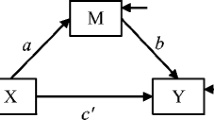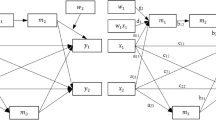Abstract
The large sample distribution of total indirect effects in covariance structure models in well known. Using Monte Carlo methods, this study examines the applicability of the large sample theory to maximum likelihood estimates oftotal indirect effects in sample sizes of 50, 100, 200, 400, and 800. Two models are studied. Model 1 is a recursive model with observable variables and Model 2 is a nonrecursive model with latent variables. For the large sample theory to apply, the results suggest that sample szes of 200 or more and 400 or more are required for models such as Model 1 and Model 2, respectively.
Similar content being viewed by others
References
Alwin, D. F., & Hauser, R. M. (1975). The decomposition of effects in path analysis.American Sociological Review, 40, 37–47.
Anderson, T. W. (1984).An introduction to multivariate statistical analysis (2nd ed.). New York: Wiley.
Anderson, J. C., & Gerbing, D. M. (1984). The effect of sampling error on convergence, improper solutions, and goodness-of-fit indices for maximum likelihood confirmatory factor analysis.Psychometrika, 49, 155–173.
Bentler, P. M. (1986). Structural equation modeling and Psychometrika: An historical perspective on growth and achievements.Psychometrika, 51, 35–51.
Bentler, P. M., & Weeks, D. G. (1980). Linear structural equations with latent variables,Psychometrika, 45, 289–308.
Bollen, K. (1987). Total, direct, and indirect effects in structural equation models. In C. C. Clogg (Ed.),Sociological Methodology (pp. 37–69). San Francisco: Jossey-Bass.
Boomsma, A. (1982). The robustness of LISREL against small sample sizes in factor analysis models. IN K. G. Jöreskog and H. Wold (Eds.),Systems under indirect observation: Causality, structure, prediction (Part 1) (pp. 149–173). Amsterdam: North-Holland.
Boomsma, A. (1983).On the robustness of LISREL (maximum likelihood estimation) against small sample size and non-normality. Unpublished doctoral dissertation, University of Groningen, Groningen.
Boomsma, A. (1985). Nonconvergence, improper solutions, and starting values in LISREL maximum likelihood estimation.Psychometrika, 50, 229–242.
Boomsma, A. (1986). On the use of bootstrap and jackknife in covariance analysis.Compstat: Proceedings of the International Association for Statistical Computing. Heidelberg: Physica-Verlag.
Box, G. E. P., & Muller, M. E. (1958). A note on the generation of random normal deviates.The Annals of Mathematical Statistics, 29, 610–611.
Browne, M. W. (1968). A comparison of factor analytic techniques.Psychometrika, 33, 267–334.
Browne, M. W. (1974). Generalized least squares estimators in the analysis of covariance structures.South African Statistical Journal, 8, 1–24.
Browne, M. W. (1982). Covariance structures. In D. M. Hawkins (Ed.),Topics in applied multivariate analysis (pp. 72–141). Cambridge: Cambridge University Press.
Browne, M. W. (1984). Asymptotic distribution-free methods for the analysis of covariance structures.British Journal of Mathematical and Statistical Psychology, 37, 62–38.
Duncan, O. D. (1970). Douncan's corrections of published text of “Peer influences on aspirations: A reinterpretation”.American Journal of Sociology, 76, 1042–1046.
Duncan, O. D. (1975).Introduction to structural equation models. New York: Academic Press.
Duncan, O. D., Featherman, D. L., & Duncan, B. (1972).Socioeconomic background and achievement. New York: Seminar Press.
Duncan, O. D., Haller, A. O., & Portes, A. (1968). Peer influences on aspirations: A reinterpretation.American Journal of Sociology, 74, 119–137.
Efron, B. (1979). Bootstrap methods: Another look at the jackknife.The Annals of Statistics, 7, 1–26.
Folmer, N. (1981). Measurement of the effects of regional policy instruments by means of linear structural equation models and panel data.Environment and Planning, 13, 1435–1448.
Fox, J. (1984).Linear statistical models and related methods with applications. New York: Wiley.
Fox, J. (1985). Effect analysis in structural equation models: Calculation of specific indirect effects.Sociological Methods and Research, 14, 81–95.
Freeman, E. H. (1982).The implementation of effect decomposition methods for two general structural covariance modeling systems. Unpublished doctoral dissertation, University of California, Los Angeles.
Gerbing, D. W., & Anderson, J. C. (1987). Improper solutions in the analysis of covariance structures: Their interpretability and a comparison of alternate respecifications.Psychometrika, 52, 99–112.
Graff, J., & Schmidt, P. (1982). A general model for decomposition of effects. In K. G. Jöreskog and H. Wold (Eds.),Systems under indirect observation, Part I (pp. 131–148). Amsterdam: North Holland.
Harlow, L. L. (1985).Behavior of some elliptical theory estimators with nonnormal data in a covariance structures framework: A Monte Carlo study. Unpublished doctoral dissertation, University of California, Los Angeles.
Jöreskog, K. G., & Sörbom, D. (1982). Recent developments in structural equation modeling.Journal of Marketing Research, 19, 404–416.
Jöreskog, K. G., & Sörbom, D. (1986).LISREL VI: Analysis of linear structural relationships by maximum likelihood and least square methods. Chicago, IL: International Educational Services.
Law, A. W., & Kelton, W. D. (1982).Simulation modeling and analysis. New York: McGraw Hill.
McDonald, R. P. (1978). A simple comprehensive model for the analysis of covariance structures.British Journal of Mathematical and Statistical Psychology, 31, 59–72.
Mosteller, F., & Tukey, J. W. (1968). Data analysis, including statistics. In G. Lindzey & E. Aronson (Eds.),Revised handbook of social psychology (Chapter 10). Reading, MA: Addison-Wesley.
Odell, P. L., & Feiveson, A. H. (1966). A numerical procedure to generate a sample covariance matrix.Journal of the American Statistical Association, 61, 199–203.
Quenouille, M. H. (1956). Notes on bias in estimation.Biometrika, 48, 433–440.
Rao, C. R. (1973).Linear statistical inference and its applications (2nd ed.). New York: Wiley.
Schrage, L. (1979). A more portable random number generator.ACM Transaction Software, 5, 132–138.
Smith, W. B., & Hocking, R. R. (1972). Wishart variate generator. Algorithm AS53.Applied Statistics, 21, 341–345.
Sobel, M. E. (1982). Asymptotic confidence intervals for indirect effects in structural equation models. In S. Leinhardt (Ed.),Sociological methodology (pp. 290–313). San Francisco: Jossey-Bass.
Sobel, M. E. (1986). Some new results on indirect effects and their standard errors in covariance structure models. In N. B. Tuma (Ed.),Sociological methodology (pp. 159–186). San Francisco: Jossey-Bass.
Sobel, M. E. (1987). Direct and indirect effects in linear structural equation models.Sociological Methods and Research, 16, 155–176.
Stone, C. A. (1985). CINDESE: Computing indirect effects and their standard errors.Educational and Psychological Measurement, 45, 601–606.
Stone, C. A. (1987).The robustness of indirect effects estimated in the Jöreskog-Keesling-Wiley covariance structure model. Unpublished doctoral dissertation, University of Arizona, Tuscon.
Swain, A. J. (1975). A class of factor analytic estimation procedures with common asymptotic sampling properties.Psychometrika, 40, 315–335.
Tanaka, J. S., & Bentler, P. M. (1985). Quasi-likelihood estimation in asymptotically efficient covariance structure models.1984 Proceedings of the American Statistical Association, Social Statistics Section, 658–662.
Zehna, P. W. (1966). Invariance of maximum likelihood estimation.The Annals of Mathematical Statistics, 37, 755.
Author information
Authors and Affiliations
Additional information
For helpful comments on a previous draft of this paper, we are grateful to Gerhard Arminger, Clifford C. Clogg, and several anonymous reviewers.
Rights and permissions
About this article
Cite this article
Stone, C.A., Sobel, M.E. The robustness of estimates of total indirect effects in covariance structure models estimated by maximum. Psychometrika 55, 337–352 (1990). https://doi.org/10.1007/BF02295291
Received:
Revised:
Issue Date:
DOI: https://doi.org/10.1007/BF02295291




